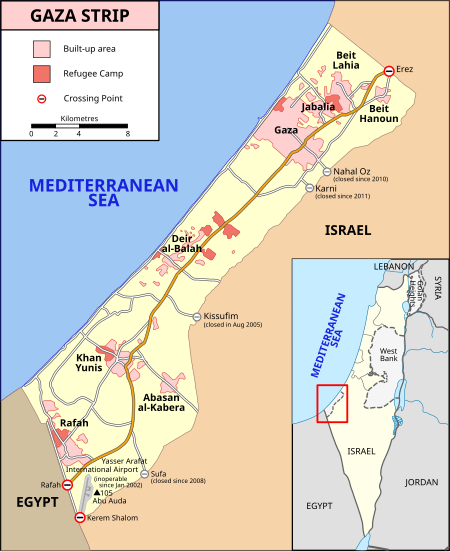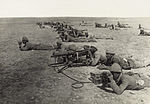Karni crossing

The Karni Crossing (Arabic: معبر كارني or معبر المنطار, Hebrew: מעבר קרני) was a cargo terminal on the Israel-Gaza Strip barrier located in the north-eastern end of the Gaza Strip that existed between 1994 and 2011 and used for the export and import of goods from/to the Gaza Strip. This was done as a 'back-to-back' transfer, meaning that Palestinian products meant for export were removed from a Palestinian truck and placed in an Israeli truck, and vice versa for incoming goods. The Karni Crossing was also used by the residents of Netzarim since the Karni road was the only route to that isolated Israeli settlement on which Jewish travel was allowed after the 1994 implementation of the Oslo Accords. The crossing has been affected by the Israeli Blockade of the Gaza Strip. At the end of March 2011 Israel permanently closed the Karni Crossing. Ten years later, in 2022, the last remaining structures of the crossing were demolished by the Israeli military.According to the management, the crossing was named after Joseph Karni, an Israeli who had set up a modern packing warehouse in the Gaza Strip near the present-day cargo terminal shortly after Israel captured the strip in 1967. The Palestinians called it Al-Montar, after the nearby Ali Montar hill.
Excerpt from the Wikipedia article Karni crossing (License: CC BY-SA 3.0, Authors, Images).Karni crossing
Sharia Al-Muntar, Gaza East Turkman
Geographical coordinates (GPS) Address Nearby Places Show on map
Geographical coordinates (GPS)
| Latitude | Longitude |
|---|---|
| N 31.474722222222 ° | E 34.473611111111 ° |
Address
Sharia Al-Muntar
888 Gaza, East Turkman
Palestinian Territories
Open on Google Maps




